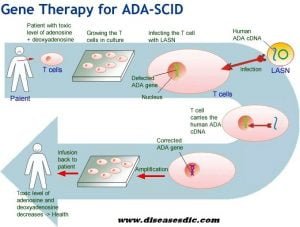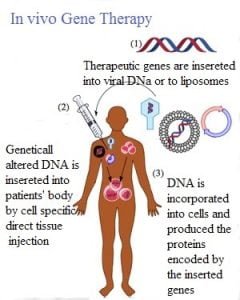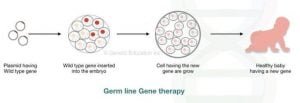Gene therapy is a method that uses genes to treat or prevent disease. It’s a means for gene improvement by introducing the correction of altered (mutated) genes or site-specific modifications. In the future, this approach may allow doctors to treat the disorder by inserting a gene into a patient’s cells instead of using drugs or surgery. Genetics offers a promising future for the healing of a wide range of genetic disorders. For example, cancer, cystic fibrosis, heart disease, diabetes, hemophilia AIDS, SCID (Severe combined immunodeficiency), etc. The ability to make local changes within the human genome has been a major medical goal since DNA information as a basic unit of life. In 1990, the first successful trial of genetic therapy for adenosine deaminase was introduced. Since then, the number of treatments developed worldwide has skyrocketed. Although the initial results of these experiments were somewhat disappointing, human genetic therapists dream of treating diseases by replacing or assisting with the production of lost or introduced genes. Further, different techniques are described, which are often used for this purpose.
Researchers are exploring a number of genetic therapies, such as:
- Transforming a genetic mutation that causes disease with a healthy copy of the gene. For example, a gene called p53 is responsible for inhibiting the growth of tumors in your body. Several types of cancer are linked to the defective p53 genes. If doctors could replace a defective p53 gene, it could cause cancer cells to die.
- Inactivate, or “knock,” an inactive gene.
- Introducing a new active functional gene to help, fight disease.
1. Somatic cell gene therapy
Therapeutic genes are transmitted to somatic cells or to patients’ bodies. Any adjustments and outcomes will be limited to each patient only, and will not be inherited by the patient’s offspring or future generations. Somatic gene therapy represents the most common current, basic and clinical research. Somatic gene therapy can also be broadly divided into two categories:
a. Ex vivo
Ex vivo (Latin: “out of the living”) refers to what happens outside the body. In ex vivo gene therapy cells are converted outside the body and transplanted. Ex vivo type treatment (Example of ADA-SCID Therapy) T-cells from the patient’s blood or bone marrow are removed and grown in the laboratory. Cells are expressed by a gene that is genetically engineered in the ADA. The virus enters cells and implants a gene into the DNA of cells. Cells are reproduced and then returned to the patient by intravenous injection.

b. In vivo
In vivo means the interior (where the genes are changed in the cells while they are in the body). This method of genetic therapy is called in vivo because the genes are transferred to cells within the patient’s body. DNA is attached to a plasmid vector or liposome vector. They will also carry specific ligands to detect specific organ receptor or target cells. They are placed in the patient. A vector binds to cells, and DNA enters the cells.

2. Germline Gene Therapy
Sperm or eggs are converted by the introduction of active genes, linked to their genomes. It can allow treatment to be developed and passed on to future generations. Germline’s genetic therapy is very effective in combating genetic disorders. The laws of many countries’ forbid gene therapy for humans, for a variety of technical and ethical reasons.

Limitations
Gene treatment is in the testing phase and is only performed on hopeless patients by other available means.
- Unwanted immune reactions. The immune system may react to these newly introduced viruses and then attack them. It can cause inflammation and, in some cases, severe failure.
- Identify the wrong cells. Since viruses can affect more than one cell, mutated viruses can affect healthy cells and not just the target cells that contain genetically modified genes. When this happens, healthy cells can be damaged, causing other diseases or illnesses, including cancer.
- Infection caused by a virus. Once infected with the virus it is possible to regain its original ability to cause infections.
- Chances of causing a tumor. If new genes are implanted in the wrong place in the DNA, there is a chance that the implant could lead to the formation of a tumor.